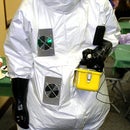Introduction: Kee Klamp Shelf
This is a shelf I built using Kee Klamps and 1-3/8" top rail fence post.
I purchased the Kee Klamps from Simplified Building Concepts, you can also get them from Grainger and McMaster-CARR prices are about the same anywhere you go (read: expensive) but Simplified Building seemed to have a better selection. The Kee Klamps are awesome and I could come up with a ton of things to build with them, but there a bit cost prohibitive to build with. All in all though they work quite well. I couldn't find the weight bearing specifications of the Kee Klamps but I was able to stand on the middle shelf (~160lbs) without failure. This was an expensive project mostly due to the use of the Kee Klamps, but they sure are cool.
Kee Klamps Parts List:
4 x Type 20-6 Side out Elbow (1")
8 x Type MH50-6 Male Single Horizontal Swivel Socket Member (1") (one for each corner of the top and middle shelf)
4 x Type 61-6 Flange (1")
~$131.34 (includes shipping to my house)
Other Parts:
Pre-cut 24"x24" plywood from Home Depot (for shelves)
4"x2" for the bottom shelf bracing
1"x1" for top and middle shelf bracing
1-3/8" top rail fence post from Home Depot
2" Casters (need to be able to pull it out to get the network equipment behind it)
Miscellaneous nuts, bolts and screws
Finish of your choosing (I used clear polyurethane)
~$120.00
Step 1: Bottom and Casters
It's probably best to build the base first since it's.. the base and will affect the placment and size of the other shelves.
I used 4"x2" for the bottom shelf, I could have gotten away with 2"x4" but I wanted to be sure that I had sufficient room for the casters and the flange bolts; plus it gives it a nice solid base. They were attached to the plywood with wood crews - 9 on each board.
I used 2"x4" casters from Home Depot, I don't plan on putting much weight on it but the casters support something like 120lbs. make sure you get casters that will hold what you plan to put on them. The casters were attached with bolts to the 4"x2".
Step 2: Caster and Flange Bolts
The pipe flanges are bolted through the ply-wood and the 4"x2" the casters are only bolted to the 4"x2" boards. Be sure to use washers on the flange bolts.
The flange bolts were to long so they were trimmed with a saws-all and angle grinder.
Step 3: Pipe Flange
The pipe flange is bolted through the ply-wood and 4"x2". Keep in mind the size of the flanges when you do your measuring to insure that you base (and other shelvs) are the size you want, because of the way I put the flanges I lost a bit of space on the bottom shelf and their positioning affects the size you can make the top and middle shelves.
since I used pre-cut ply-wood it was square enough if you cut your own make sure the wood is square and that the flanges end up square too.
Step 4: All Together Now
Once I had all the flanges in place I fitted to fence post in them, it was a bit scary because without any other support the fence post wobbles even with the set screw tightened. I'd keep everything lose at this point just enough so that you can measure for the sizing of the other shelves.
Step 5: The Shelves
I would (i did) measure and make the shelves before I attached the top kee klamps and fence post. To measure for the shelf size attach the Horizontal Swivel Socket Member (funny name) and measure from the inside of one Horizontal Horizontal Swivel Socket Member to the other.
If your good you could figure out the sizing before hand but my brain does not work like that, I get a good idea of what I will need, sizes, etc. and start building.
Notice how my Horizontal Swivel Socket Members angle in (~45 degrees) that was not originally how I intended them to end up, I cut the first shelf wrong (to small) and angled in the Horizontal Swivel Socket Members to fit rather than buy another piece of ply-wood. I added the 1"x1" to help beef up the shelves where the bolts went through.
Step 6: Horizontal Swivel Socket Member
The Horizontal Swivel Socket Members were attached with lag bolts. I used tapered bolts so that they would sink into the wood and sit flush. At this point everything is still pretty loose, you want to get all the shelves and the top pipe on then you can start tightening while making sure things stay even and level.
Step 7: Top
Once all the shelves are attached put the top kee klamps on (Side out Elbows) measure and cut for the lengths of pipe (or fence post) that you will need. See the picture for some more notes.
Step 8: Final Thoughts
Once the top is in place and the Side out Elbows are level start to level the shelves at the Horizontal Swivel Socket Members. It will take some time to get them level.
I hand tightened the set screws, I didn't use a torque wrench because I was concerned that if I went to tight it could puncture the fence post.
Participated in the
The Instructables Book Contest













